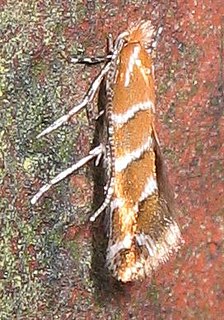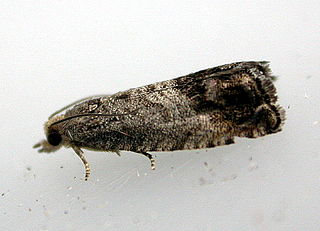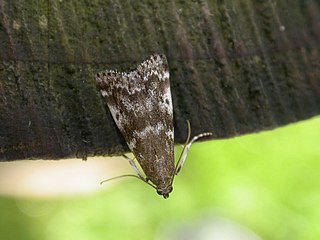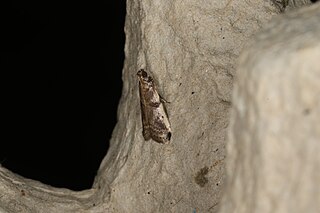
The chestnuts are a group of eight or nine species of deciduous trees and shrubs in the genus Castanea, in the beech family Fagaceae. They are native to temperate regions of the Northern Hemisphere.

The horse-chestnut leaf miner is a leaf-mining moth of the family Gracillariidae. The horse-chestnut leaf miner was first observed in North Macedonia in 1984, and was described as a new species in 1986. Its larvae are leaf miners on the common horse-chestnut. The horse-chestnut leafminer was first collected and inadvertently pressed in herbarium sheets by the botanist Theodor von Heldreich in central Greece in 1879.

The Lymexylidae, also known as ship-timber beetles, are a family of wood-boring beetles. Lymexylidae belong to the suborder Polyphaga and are the sole member of the superfamily Lymexyloidea.

Ypsolopha asperella is a moth of the family Ypsolophidae. It is found in Northern and Central Europe, Siberia, Korea, China, Asia Minor and Mideast Asia.

Cydia splendana, the chestnut tortrix, is a moth of the family Tortricidae. It is found in Europe. It is also known as the acorn moth, but this can also refer to Blastobasis glandulella from North America, which belongs to the more primitive family Blastobasidae.

Assara terebrella is a moth of the family Pyralidae. It is found in Europe, Korea, Japan (Hokkaido) and eastern Siberia.

Epiblema foenella, the white-foot bell, is a moth of the family Tortricidae.

Pammene fasciana, the chestnut leafroller, is a moth of the family Tortricidae. It is found in Europe and across the Palearctic.

Coleophora vestianella is a moth of the family Coleophoridae. It is found from Europe to Asia Minor, Iran, Afghanistan, China, the Korean Peninsula and Japan.
Assara albicostalis is a moth of the family Pyralidae. It has a wide distribution and has been recorded from India, Sri Lanka, Thailand, Sabah, the Philippines, Taiwan, Sulawesi, Australia, Fiji, Tahiti, Samoa, Hawaii and the Marquesas. This is the type species of genus Assara.

Zimmermannia bosquella is a moth of the family Nepticulidae. It is found in Virginia, Ohio and Kentucky in the United States. It is now classified as conspecific with the American chestnut moth, which was formerly considered as extinct.

Agriphila deliella is a species of moth of the family Crambidae. It is found in most of Europe and North Africa and from Anatolia to Afghanistan.

Ypsolopha is a genus of moths of the family Ypsolophidae. It is the type genus of the family and comprises over 120 described species.

Assara is a genus of small moths belonging to the snout moth family (Pyralidae). They are part of the tribe Phycitini within the huge snout moth subfamily Phycitinae.
Assara inouei is a species of snout moth in the genus Assara. It was described by Hiroshi Yamanaka in 1994 and is known from Japan, Korea and China.
Assara korbi is a species of snout moth in the genus Assara. It was described by Aristide Caradja in 1910 and is known from eastern Asia, including Japan.

Assara seminivale, the kernel grub or macadamia kernel grub, is a species of snout moth in the genus Assara. It was described by Turner in 1904, and is known from Australia. There are also records for Sikkim, Tonkin, Sri Lanka, Sumatra and Borneo, but these need verification.
Assara funerella is a species of snout moth in the genus Assara. It was described by Ragonot in 1901. It is found in Taiwan, Japan, China and Korea.
Gynnidomorpha minimana, the fen conch, is a moth of the family Tortricidae. The species was first described by Aristide Caradja in 1916. It is found in China, Taiwan, Japan, Korea, Russia and Europe, where it has been recorded from Ireland, Great Britain, the Netherlands, Italy, France, Germany, Denmark, Norway, Sweden, Finland, Estonia, Latvia, Lithuania, Slovakia, Poland, Romania, Hungary, Albania and Corsica. The habitat consists of heathland and mosses.

Elophila nigralbalis is a moth in the family Crambidae. It was described by Aristide Caradja in 1925. It is found in Japan, Vietnam, Indonesia and Taiwan.













